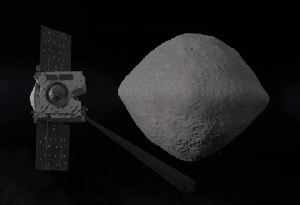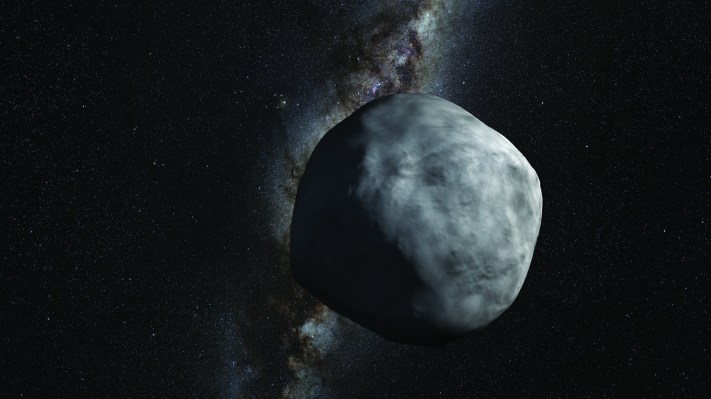NASA’s OSIRIS-REx spacecraft has successfully launched from Cape Canaveral with the help of 1.2 million pounds of thrust provided by an Atlas V rocket. The spacecraft will journey to a near-Earth asteroid known as Bennu and return an asteroid sample to Earth. This will be NASA’s first asteroid sample return mission.
Designed to return a sample as large as two kilograms, the mission is likely to bring back the largest sample of alien rock since the Apollo 17 mission in 1972.
This mission is the first of its kind for NASA and is a uniquely difficult one.
Grabbing a space rock and bringing it back to Earth may not seem that complicated, but mission success for OSIRIS-REx will be dependent on the execution of a number of complex maneuvers over the course of nine years.
Here are just a few of the things that NASA’s asteroid sample return mission must get right to complete a successful mission. OSIRIS-REx will need to fly toward Bennu at 12,000 mph and then pump the brakes to less than 0.5 mph to intercept the asteroid. Then, a relatively large sample will need to be collected in the tricky environment of microgravity. If that sample gets contaminated by anything the spacecraft brought from Earth, or from something else it encounters before it can be delivered to a clean room for analysis, the mission is compromised. So, OSIRIS-REx must go above and beyond to protect that sample, especially during the intense return through the Earth’s atmosphere.
NASA isn’t the first to attempt this difficult feat. The Japanese Aerospace Exploration Agency (Japan’s NASA-equivalent organization) launched the first asteroid sample return mission back in 2003, but things went awry once the spacecraft reached the asteroid and a large sample was unable to be collected.
While a successful launch is a great first step, the OSIRIS-REx team won’t be able to breathe a sigh of relief until September 2025, when the Bennu sample has successfully been brought home and analyzed.
OSIRIS-REx, which stands for Origins Spectral Interpretation Resource Identification Security-Regolith Explorer, will reach the Bennu asteroid in August, 2018. Upon arrival, the spacecraft will take months to analyze the asteroid and identify a scientifically interesting section to sample.

OSIRIS-REx surveying Bennu / Image courtesy of the University of Arizona
A couple of years later, around July 2020, OSIRIS-REx will use a robotic instrument known as TAGSAM to make contact with the asteroid and shoot a burst of pure nitrogen gas at the rock. This gas will push bits of the asteroid’s surface into a sampling chamber.
Then, in March, 2021, OSIRIS-REx is scheduled to depart Bennu and begin its trip home. The spacecraft should reenter the Earth’s atmosphere in September, 2023. At that time, the sample will be delivered for two years of thorough analysis at NASA’s Johnson Space Center.
Why is NASA going through all of this trouble to study an asteroid?
Well, for one, this particular asteroid has the potential to impact Earth in the 22nd century — and it’s large enough to do some damage. Because of this, there’s the possibility that we may want to intercept Bennu in the future for the purpose of deflection. So, there’s benefit to flight-testing some of these capabilities now (before some people’s lives depend on it).
There’s also significant scientific reasons for studying asteroids. Scientists believe that asteroids are primitive rocks — leftover debris from the formation of the planets in our solar system created billions of years ago.
As an added benefit, asteroids don’t have recycling processes like we have here on Earth (wind, water, tectonic plates, etc.), so they haven’t changed much since their formation, making them uniquely interesting scientific specimens.
Because of their historical significance, studying an asteroid like Bennu could help us understand how planets form.
Perhaps the more interesting reason to analyze a Bennu sample is that it could help us understand how life began here on Earth. There’s a theory known as panspermia that states that microbial life was carried to Earth by asteroids, meteoroids, comets or other orbiting planetary bodies. Scientists predict that Bennu contains organic materials, which is one of the ingredients for creating life as we know it.
To test the panspermia theory, the OSIRIS-REx team will work hard to identify a section of the Benny asteroid that contains organic material for sampling.
Nine years may sound like a long time, but NASA’s most ambitious planetary spacecraft (New Horizons, Voyager, Juno, etc.) have always taken many years to complete their mission. And if everything with OSIRIS-REx goes according to plan, we may just have answers to some of the biggest questions scientists have asked about the formation of Earth and the origin of life.
